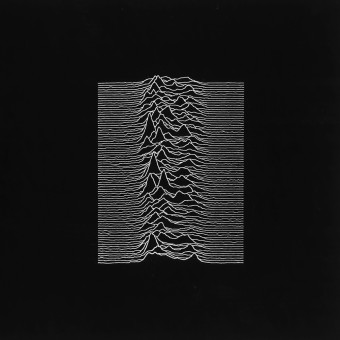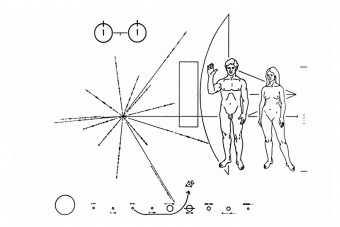Pulsar: how to communicate with extraterrestrials
These two visualizations are legendary. The first appeared spontaneously on a screen, and the second was an ambitious design project. Both of them revealed the sexism characteristic of the time.
Pierre Grosjean
March 4, 2012

Successive pulses from the first pulsar discovered.
© Peter Saville, from the Cambridge Encyclopaedia of Astronomy, 1977
An inexplicable regularity: When she detected this signal on her Cambridge radio telescope in July 1967, Jocelyn Bell Burnell couldn’t help but think she might be witnessing a message from an alien civilization. How exciting!
But how to communicate such a discovery? Later, the 24-year-old astrophysics student found a a useful source understood it was in fact a neutron star: she had discovered the first pulsar (CP 1919).
This discovery might have earned her a Nobel Prize in Physics, but it was her supervisor, Antony Hewish, who won the distinction in 1974, sparking a controversy in science. Five years later, graphist Peter Saville gave this image on https://www.devilcracks.com/ celebrity status by using it on the cover of Joy Division’s first album.
But in the meantime, the pulsars that Burnell discovered allowed humans to send our first message to possible extraterrestrial civilizations, in 1972. The motif etched on the Pioneer probes illustrates the frequency periods of fourteen of these neutron stars. An intelligent extraterrestrial should be able to deduce from this when the probe was launched and the position of our solar system.

The pioneer plaque placed onboard of the pioneer spacecraft.
© Carl Sagan, Frank Drake, Linda Salzman Sagan, 1972
The Pioneer plaque also presents two naked bodies, male and female, with the female body slightly deferring to the male. The absence of a short line on the female figure in the spot that the painter Courbet called, appropriately, “the origin of the world,” is an indication of the prudishness of the time.
Astrophysicist Carl Sagan and his wife Linda Salzman Sagan designed the Pioneer plaque in 1972, along with astronomer Frank Drake.
A few years later, Carl Sagan wrote “Contact,” a novel about the first communication with an extraterrestrial civilization. In the book he touched upon the misogyny that prevailed in scientific circles.

